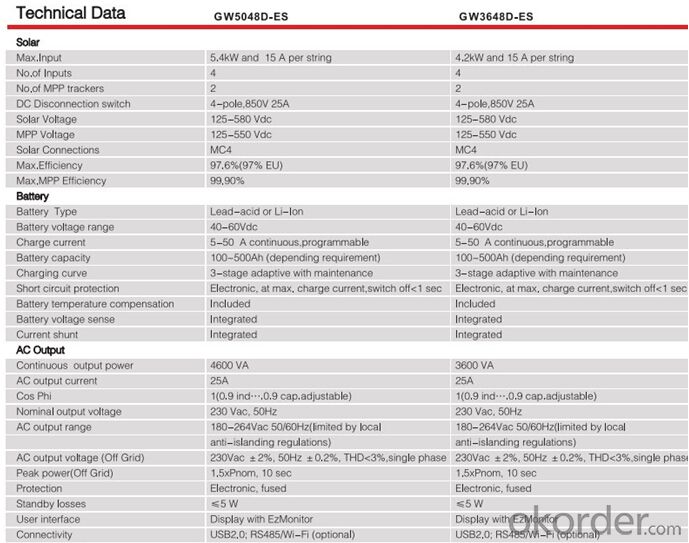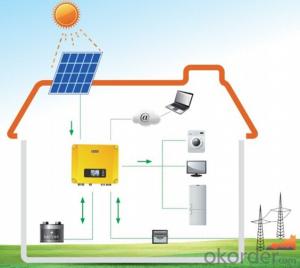Hybrid solar inverter GW5048D-ES
OKorder Service Pledge
OKorder Financial Service
You Might Also Like
GW5048D-ES series bidirectional energy-storage inverter is applicable for both on-grid and off-grid PV systems and can control the flow of energy hybrid with its working situation able to be switched automatically or manually. During the day time, the PV plant generates electricity which can be provided to the loads, fed into the grids or charged the battery. The power stored can be released when the loads require it during the night. Additionally, power grid can also charge the storage devices via the inverter..
Datasheet

- Q:Can a solar inverter be used with solar-powered agricultural equipment?
- Yes, a solar inverter can be used with solar-powered agricultural equipment. A solar inverter is an essential component in a solar power system as it converts the DC (direct current) electricity generated by solar panels into AC (alternating current) electricity that can be used to power various equipment, including agricultural machinery.
- Q:What is the maximum AC voltage that a solar inverter can provide?
- The maximum AC voltage that a solar inverter can provide depends on the specifications of the specific inverter model. However, for most common residential and commercial solar inverters, the maximum AC voltage typically ranges between 208 and 240 volts.
- Q:How does a solar inverter handle voltage fluctuations from the grid?
- A solar inverter handles voltage fluctuations from the grid by constantly monitoring the voltage and adjusting its output accordingly. When the grid voltage increases or decreases, the inverter's control system regulates its own output voltage to match the changes, ensuring a stable and consistent supply of electricity is fed into the grid. This helps to maintain grid stability and protect the connected devices from potential damage caused by voltage fluctuations.
- Q:Can a solar inverter be used with micro-inverters?
- Yes, a solar inverter can be used with micro-inverters. In fact, it is a common practice to combine a central solar inverter with micro-inverters in a solar system. The central inverter is responsible for converting the direct current (DC) power generated by the solar panels into alternating current (AC) power, while the micro-inverters optimize the power output of each individual solar panel. This combination allows for increased efficiency and flexibility in managing the solar system.
- Q:What is the maximum number of MPPT inputs in a solar inverter?
- The maximum number of MPPT inputs in a solar inverter can vary depending on the specific model and brand. However, in general, solar inverters can have anywhere from one to multiple MPPT inputs, with some high-end models offering up to six or more MPPT inputs.
- Q:What is the maximum short-circuit current that a solar inverter can handle?
- The maximum short-circuit current that a solar inverter can handle depends on its specific design and specifications. It varies from one model to another, but typically, solar inverters are designed to handle short-circuit currents within the range of 10 to 25 times their maximum continuous output current. However, it is crucial to consult the manufacturer's guidelines or product specifications for the exact maximum short-circuit current rating of a specific solar inverter model.
- Q:Can a solar inverter be used with energy storage systems?
- Yes, a solar inverter can be used with energy storage systems. In fact, integrating an energy storage system with a solar inverter allows for the efficient utilization and management of solar-generated electricity. The inverter not only converts the DC power from the solar panels into AC power but also controls the charging and discharging of the energy storage system, ensuring optimal usage of stored energy.
- Q:How does a solar inverter handle reactive power compensation?
- A solar inverter handles reactive power compensation by integrating power factor correction techniques. It actively monitors the power factor of the connected load and adjusts the reactive power flow accordingly. This ensures that the inverter delivers a balanced combination of active (real) power and reactive power, resulting in improved system efficiency and reduced power losses.
- Q:How do you calculate the power loss in a solar inverter?
- To calculate the power loss in a solar inverter, you need to determine the difference between the input power and the output power. Subtracting the output power from the input power will give you the power loss.
- Q:How does a solar inverter handle frequency variations in the grid?
- A solar inverter handles frequency variations in the grid through its built-in control mechanisms. It continuously monitors the frequency of the grid and adjusts its own output accordingly to match the grid frequency. This ensures that the solar inverter remains synchronized with the grid and allows for seamless power transfer between the two.
1. Manufacturer Overview |
|
|---|---|
| Location | |
| Year Established | |
| Annual Output Value | |
| Main Markets | |
| Company Certifications | |
2. Manufacturer Certificates |
|
|---|---|
| a) Certification Name | |
| Range | |
| Reference | |
| Validity Period | |
3. Manufacturer Capability |
|
|---|---|
| a)Trade Capacity | |
| Nearest Port | |
| Export Percentage | |
| No.of Employees in Trade Department | |
| Language Spoken: | |
| b)Factory Information | |
| Factory Size: | |
| No. of Production Lines | |
| Contract Manufacturing | |
| Product Price Range | |
Send your message to us
Hybrid solar inverter GW5048D-ES
OKorder Service Pledge
OKorder Financial Service
Similar products
New products
Hot products
Hot Searches
Related keywords





























